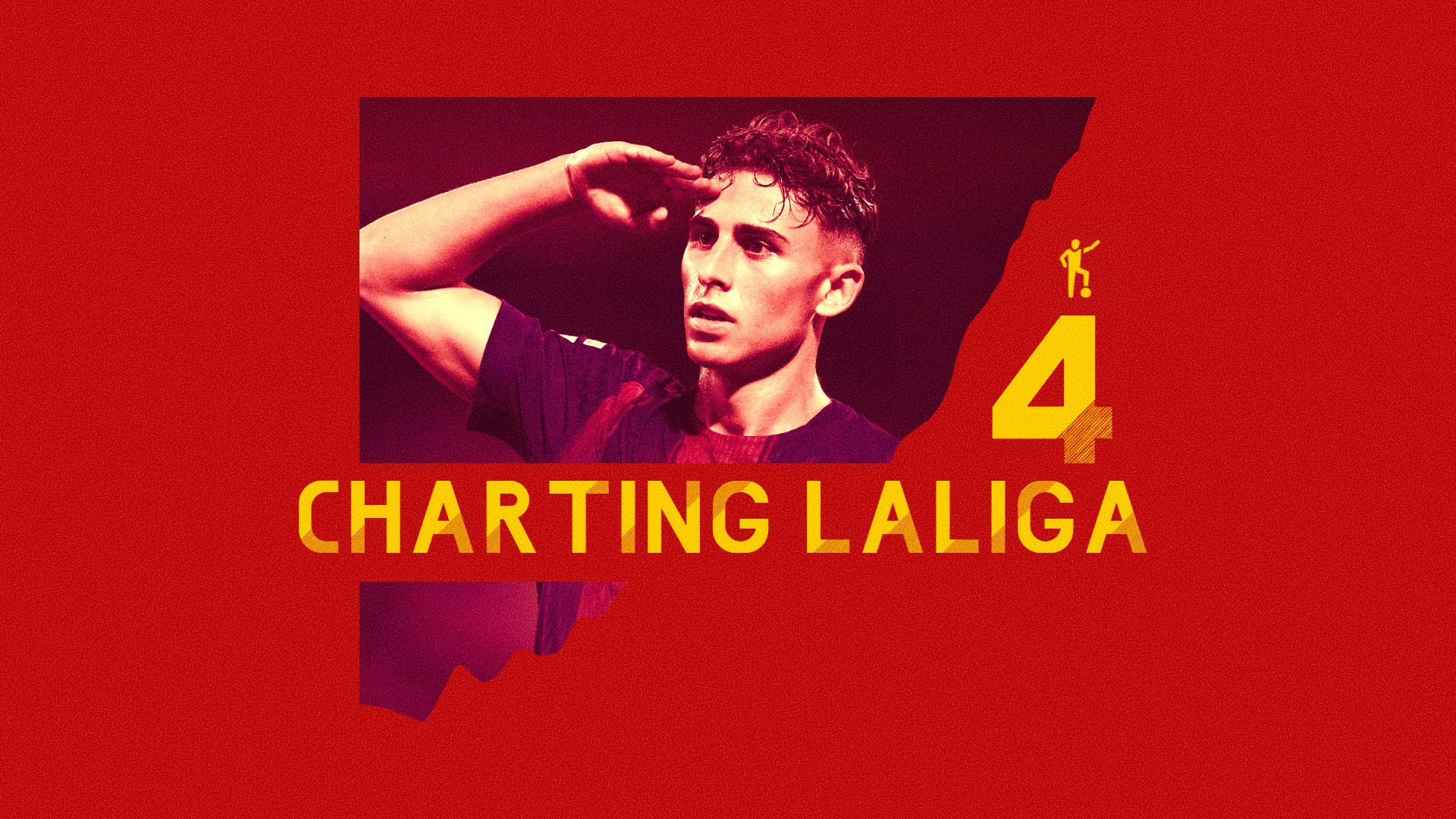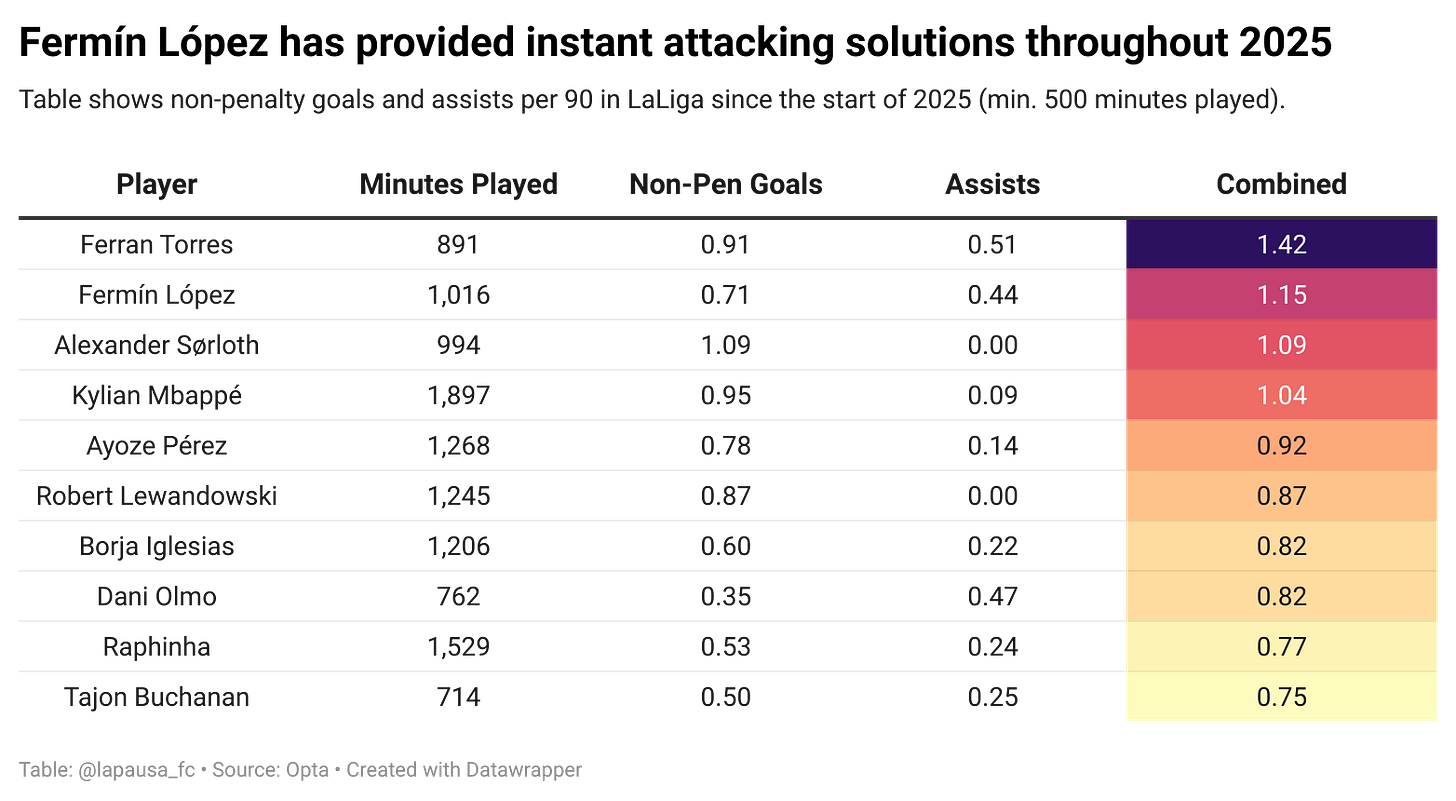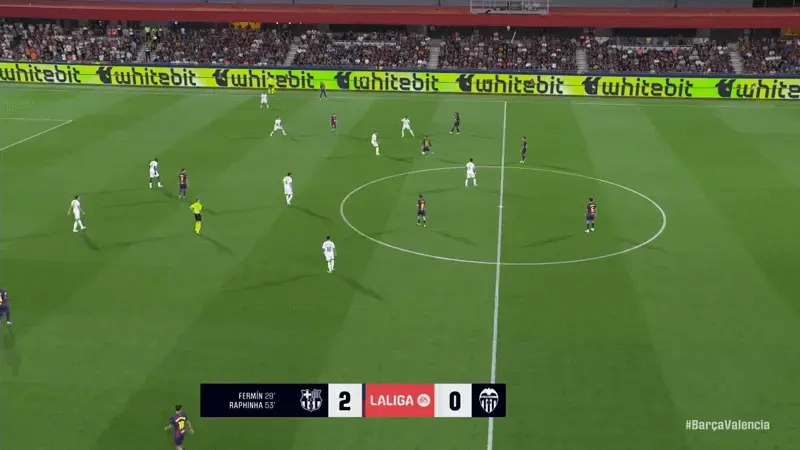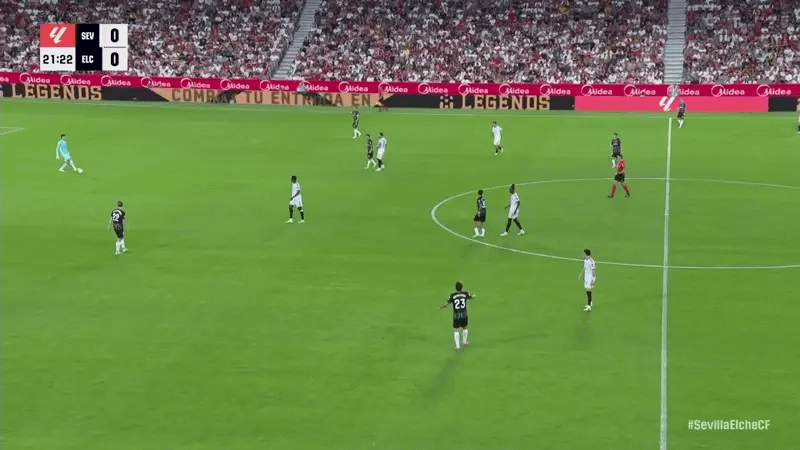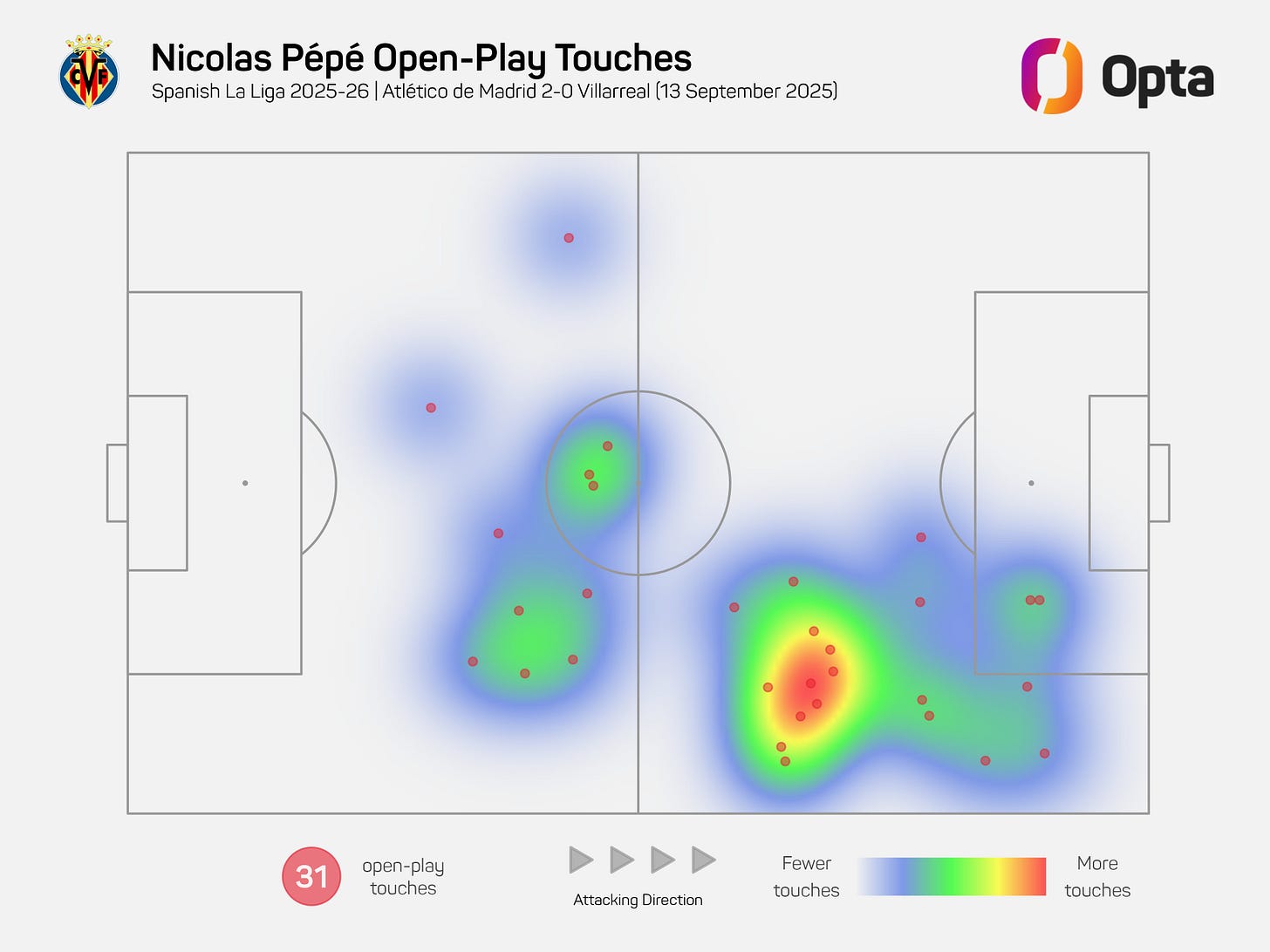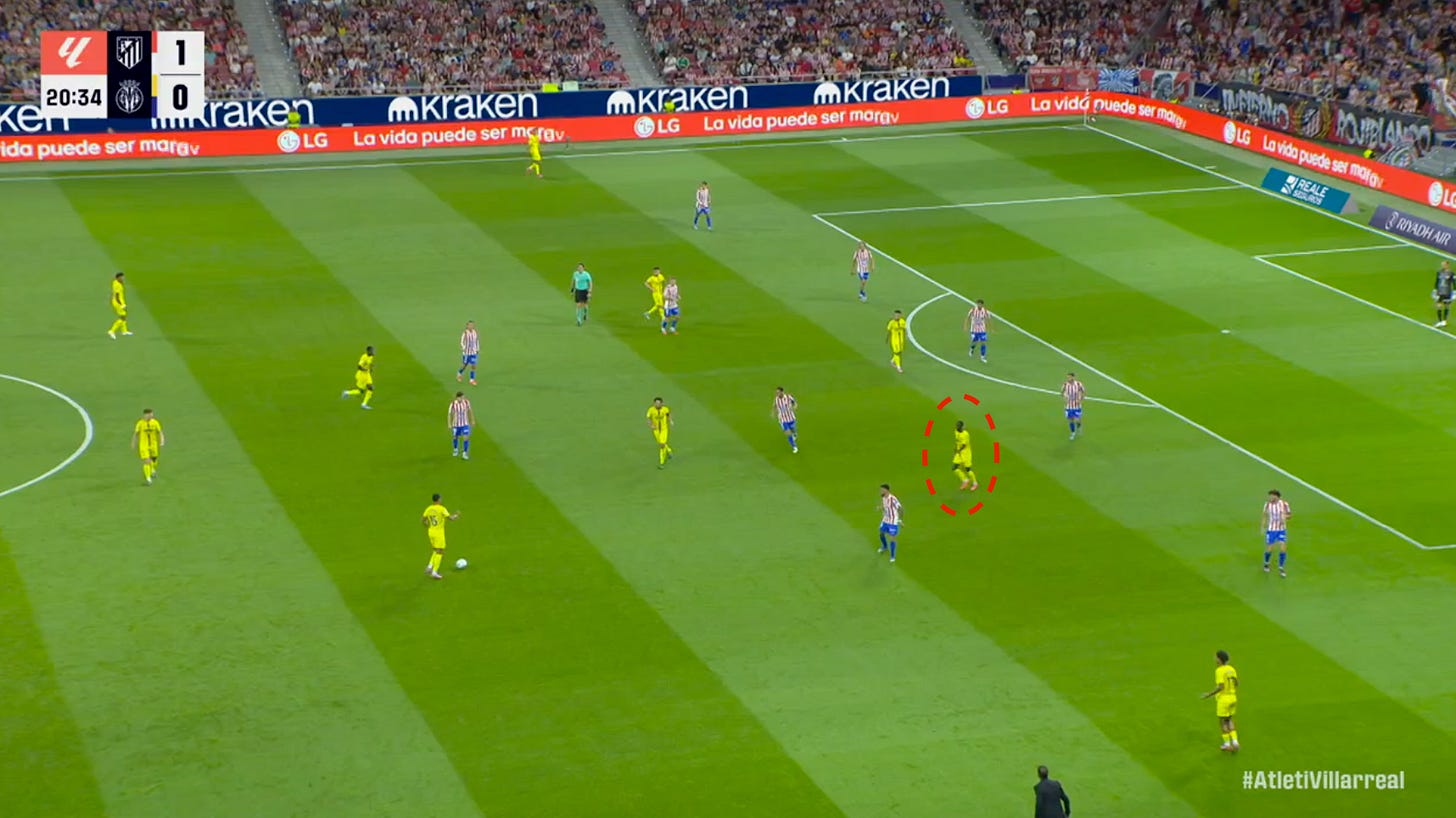Charting LaLiga #4: Five star Fermín, Almeyda's man-to-man bet, inevitable Bordalás (& more)
A new addition to our coverage this season, Charting LaLiga will be a fixture after every matchday.
The premise is simple. Every week, we’ll churn out some points of interest from around the league in a (hopefully) digestible, easy-to-read manner. And of course, there will be a data element behind much of it.
Charting LaLiga will be a space for all types of insights, no matter the breadth of the topic or which team or player is under the spotlight. Sometimes they’ll be on the big themes everyone is aware of; other times they’ll be minuscule details that wouldn’t warrant an article of their own (but have a small place here).
All posts will typically be made up of anywhere between 3-6 sections, and you can expect these to land by Tuesday (following the usual Monday night fixture).
Any feedback, do let us know on here or X!
Five star Fermín shreds Valencia
“As I said, with the [transfer] window closed, I’m really happy with the situation. Now we can concentrate on the football,” said Hansi Flick, shortly after Barcelona’s 6-0 demolition of Valencia.
After such a positive collective display, that went for the whole team. But a large part of that was inevitably related to Fermín López — the player most at risk of a late departure — who was subject of a bid from Chelsea during the window. Fortunately for Flick, that one passed by as a mere scare.
It’s tempting now to say that, with the window shut and his immediate future cleared up, the 22-year-old’s performance on Sunday night was notably high. However, the reality is that this is who Fermín has been for quite some time already. The fact that he doesn’t start every game shouldn’t cloud that, when he’s sent out on the pitch by Flick, he rarely passes by without event.
Indeed, he has been one of the most influential attacking players in the league in 2025. Since the turn of the year, no midfielder in LaLiga has a better minutes per goal involvement ratio (1.15 per 90 — 0.71 goals and 0.44 assists).
Sunday night at Estadi Johan Cruyff was more of the same. Fermín opened the scoring in the 29th minute, then added a third to truly take the game away from Valencia just before the hour mark. His impact on the game was much more profound than just being the one to put the ball in the back of the net, though.
A constant throughout the game — and a big reason why Barça were so freely able to open up avenues of attack — was through Fermín’s play in between the opposition’s defence and midfield. Even with Valencia switching to a back five to match up numbers-wise, the youngster’s subtlety and variety of movement proved all too much for a defence that needed to be at their concentrated best, if they were ever to stand a chance.
Fermín’s second goal arrived in just that scenario. First, he drops deep and gauges whether Copete (LCB) is going to follow him or drop off. When the defender obliges, he runs him the other way and drags him deep, before beating him back to a comfy spot between the lines. The icing on the cake is, of course, a clean strike off his weaker foot, which is a clear advantage of his when compared to Dani Olmo (as his main competition).
Shortly after, Fermín breaks loose in between the lines again — this time on the other side of the pitch, moving off César Tárrega (RCB) instead of Copete (LCB).
Instead of running deep and then coming back to find the space, this time Fermín takes up his starting spot with Tárrega and feigns as if he’s merely going to maintain his position and wait for the ball to circulate around.
But when Marc Casadó (#17) drops into his own half, Fermín sees his chance and darts in front of Mouctar Diakhaby (CCB) — already occupied by Ferran Torres — to find the pass through the middle of Valencia’s midfield. Even with Valencia not being outnumbered at the back, those timed movements to find central space often left them looking like they were.
It’s been a long enough period now to say that this is simply what Fermín gives an attack as good as Barcelona’s already is.
He’s direct, moves with equal amounts of craft and hustle, and brings a variety of technical attributes that further the team’s aims of attacking with rhythm and aggression. And, increasingly, he is showing he can produce the defining last action — be it a strike or an assist — that will take him ever closer to becoming a first line option in Barcelona’s attacking machine.
Hansi Flick was desperate to keep him at the club — and if we ever needed a reminder why (we didn’t), well Sunday night sure provided us with one.
JK
Sevilla present Elche with a new look
The 2-2 draw between Sevilla and Elche on Friday night was a pretty fair result. The game was short on action in both boxes, the four goals all arrived in pretty random fashion, and there were just 12 shots were attempted between the two sides; the fewest in a LaLiga game so far this season.
As is the case when facing an Eder Sarabia, much of the game tends to happen between the boxes. Elche look to build advantages from the back every time down, using short passes, making their goalkeeper an extra outfielder, and using subtle positional adjustments to figure their way around the opposition. If you don’t actively hurry them up, they’ll take their sweet time in doing that.
It was no different on Friday night. Except for the fact that, unlike in their first three games, their opposition presented a pretty full on man-to-man approach from the first minute. Sevilla switched to a 5-2-3 without possession and sent one of their CBs — usually Marcão to begin — all the way in to latch onto the spare Elche midfielder.
The message was clear: we'd prefer you to play over the top.
Elche probably knew it was coming. Sevilla had done similar away at Girona in week two. But they still struggled to address it, and were guided into game-low figures across the four opening matchdays for 10+ pass sequences (6) and average sequence time (7.1 seconds). They were forced into playing longer and quicker, without gaining much advantage against Sevilla’s obvious risks at the back.
Sevilla, meanwhile, forced 15 high turnovers in the match — the second most by a team in a game this season (only behind Real Madrid’s 16 at Real Oviedo). And although they didn’t manage to turn any of them into goals, there was an evidently unsettling effect that didn’t allow Elche to tee up their usual easing into matches; linking short passes, frustrating the home crowd, punishing undisciplined jumps. Sevilla turned those short pass options into trickier ones and lived with anything that bypassed midfield.
And even when Elche did manage to connect those passes from back to front, finding a rhythm of play once the ball came down often evaded them. Sevilla stayed attached to markers — note Marcão on Ali Houary below — and collapsed around those short passes.
As one would expect, it’s not to say it was all clean on the home side’s part. Dangers arose when one of the centre backs didn’t arrive to the spare midfielder in time, as we saw in the example with Azpilicueta below. (Elche’s front two generally do a good job of occupying three centre backs, providing that hesitation even for Sevilla’s approach)
To be clear, there’s no win-win defensive approach when playing Elche. Sit off them and they’ll keep the ball for an eternity and sink you deep (as they did against Levante). Press them high and aggressively and eventually they’ll play through. Their team is full of technicians. But watching them at Sevilla, there’s an element of forcing uncomfortability that feels like it will quickly become necessary when facing them.
Elche want to play short and slowly wrangle their way through and around you while keeping the game under their spell — they don’t want to punch from back to front all that often, even if the opportunities are there for it to be viable. Nor are they a particularly quick team in the front part of the pitch.
Again, a draw was a fair result with neither side ever really looking worthy of a win. But it was an instructive game on how teams will go about approaching Elche across the season, with those coming after having the benefit of assessing what’s worked and what hasn’t until now. Though the scoreline on Friday said two goals scored, the visitors only had two shots in open play over 102 minutes of game time.
Sevilla were the most aggressive so far — and most successful. Look out for teams taking inspiration from Matías Almeyda in coming weeks and months.
JK
Beñat Prados is a sensitive loss for Athletic
It’s been a bad few days for Athletic Club. Losing at home to Alavés on Saturday, and then receiving the news on Monday morning that Beñat Prados has suffered an ACL injury, wasn’t exactly in line with their otherwise positive three wins from three to kick off the campaign.
Inevitably, the news about Prados is unwelcome. Losing a first team contributor always is. But it’s unwelcome in a variety of annoying, disruptive ways for Athletic — a team who won’t just leap into the market and sign a replacement (and would have to wait months to do so anyway).
Firstly, there was plenty of reason to expect a jump from Prados this season on an individual level. With consecutive 2,000+ minute seasons in the bag, the 24-year-old has played a good amount of football in a side who have been pretty consistent with their idea, style of play, and surrounding personnel. By this point, Prados is well versed in what it takes to be a midfielder in Valverde’s side. He excels on the out-of-possession side, especially.
If that could have been accompanied by continued growth in possession — even if it were only subtle — Athletic would have a starting option for now and the long haul to pair with Mikel Jauregizar (who already ticks both of those boxes).
To be clear: Iñigo Ruiz de Galarreta remains a tremendous player and partner for Jauregizar, but the club will no doubt be thinking about his successor — or successors — already. One only need look at the careful management of his minutes last term, which will no doubt continue in this one too.
Beyond the hypotheticals, what we know in the present is that the absence of Prados really hits Athletic’s midfield rotation hard. Ruiz de Galarreta and Jauregizar — one of the great engine room pairs in LaLiga — are now going to have to play more. And if that’s not the case, then next in line is Mikel Vesga — an experienced player valued by Valverde, but one who chips away at Athletic’s front foot, energetic identity due to a lack of athleticism. Even in short cameos this term, he has looked a step slow and struggled on the intensity front.
In other words, added fatigue will not be conducive to Athletic doing what they do best (nor will leaning on Vesga more). Playing with a high rhythm, stealing the ball, and attacking in quick bursts that favour volume over precision is what has underpinned the rise of Valverde’s Athletic. “We’re a team that has to squeeze the opponent, and make it so that they can’t play or [at least] try to make them play less,” as he said after their recent win at Betis.
The other option for Athletic is to promote Alejandro Rego, who is yet to play a half of football at senior level. And of course, that’s not exactly a problem for a club in their position — blooding youngsters is what they’re aiming to do.
The thing is, now simply isn’t a great time to be experimenting. Athletic are just commencing a season where they’ll fight to be among the best four sides in LaLiga — Ernesto Valverde stresses it is still their priority — while having to perform in the Champions League and their dear Copa del Rey. With such a clear line of ascendancy in recent years, Valverde and Athletic are primed to compete now.
Athletic opted for a four of Jauregizar, Ruiz de Galarreta, Prados and Vesga to cover the two deeper midfield roles in 2025-26, which still made plenty of sense just a matter of days ago. Now, however, the necessary compensations that will have to be made in Prados’s long term absence look like a hazard against continued performance.
Los Leones needed Prados the player — but they also needed him to protect their front line duo of Ruiz de Galarreta in Jauregizar, in what promises to be a long season.
JK
Bordalás the Resourceful
The musical chairs at Getafe at the close of the transfer window must have had José Bordalás sweating.
Christantus Uche, his man-mountain of a centre-forward, was courted by several clubs. He seemed set for Wolves before backing out, intent on staying put. Then Crystal Palace came in with an offer neither Uche nor Getafe could refuse. He was sold, and Bordalás was left ruing the loss.
“The circumstances at the club,” as Bordalás calls them, are an ongoing theme at Getafe — the lack of cash, the inability to reinforce the squad, the constant scraping by. He mentions it often in press conferences. Yet somehow, they’ve taken nine points from their first 12, with wins over Celta Vigo, Sevilla and Real Oviedo.
There’s no depth to speak of, but Bordalás is proving himself one of the most resourceful coaches in the league. Getafe have used just 19 players so far — only Osasuna have used fewer. And in all four matches, he’s kept the same midfield, and the only change up front has been swapping Borja Mayoral for Uche.
His vision is crystal clear. A fifth of their passes have been hit long (21%) — a league-high mark — and they revel in being the direct antiheroes of the divison, before backing it up with an ultra-aggressive defence where everybody defends. It may rile plenty of people, but it can also be exactly what some players need to reach their best level.
Often caricatured as the anti-football man, Bordalás has a knack for improving players. In each of the last three seasons, Getafe have sold someone for over €10 million — the latest being Uche, reportedly for €20 million.
There are others who could soon follow that path. Davinchi, just 17 and signed from the Primera RFEF, has already earned meaningful minutes. And Mario Martín looks the part too, showing bright moments with the ball to compliment his usual defensive graft. There’s over-exuberance in his challenges, sure, but that will be harnessed (and might even be encouraged at his new club). All the while, he’s getting valuable minutes in a competitive team.
Don’t be fooled by the bright start. Once injuries, fatigue, and midweek fixtures hit, Getafe will likely be dragged further towards the relegation fight. But with Bordalás, they won’t go quietly and we are sure to see a couple of players excel in their roles under him.
RD
Villarreal’s second striker is first class
Villarreal’s summer overhaul was sweeping. Returning to the Champions League, they clearly decided they needed more depth and variety. Ten new players arrived, while key pieces of Marcelino’s old guard such as Álex Baena and Yéremy Pino were sold.
One player who stayed, and who has stepped into a bigger role, is Nicolas Pépé — Marcelino’s wild card in a team built to endure, but which can adapt to largely whatever the opponent throws at them.
The re-signing of Taj Buchanan has been crucial, especially with Gerard Moreno and Ayoze Pérez out injured and Etta Eyong sold. It allows Pépé to play as a second striker in Marcelino’s 4-4-2, without sacrificing much on the right wing. Buchanan doesn’t have Pepé’s ball-carrying or goal threat, but that’s the point: he plays safer, takes fewer risks, and gives Marcelino a bit more peace of mind in shoring up the right side of the team in a more balanced way.
Indeed, it also helps mask Pépé’s erratic defensive effort. With Buchanan and Santiago Mouriño locking down the right, Pépé can hover higher up the pitch — ready to strike on the counter, where he’s proven lethal. Although it’s far from the only avenue where he’s showing his threat.
Despite defeat for his side away to Atlético Madrid, he was Villarreal’s most dangerous piece on the board. From his second-striker berth, he dropped between the lines while Buchanan opened up the width, forcing Atlético’s defence to collapse in on him. And he repeatedly pulled Lenglet out of the back line, destabilising their shape out of fear of letting Pépé receive in the gap.
Although largely known throughout his career as a touchline winger who likes to cut inside, the Ivorian has been spectacular so far when receiving passes in central areas and on the half-turn, before accelerating towards defenders and committing them — as Lenglet inevitably feared at the weekend.
There was good reason for it. Through the opening four rounds, Pépé ranks in the top five wingers for both completed dribbles (2.5) and long progressive carries (6.7) per 90. He is a player who opponents can’t afford to let receive and turn, even if it comes at the expense of hauling a defender out and opening gaps behind.
As for the actual creation, he has averaged 0.99 combined xG and xA per 90 across his 270 minutes. Of players to have played as many — the equivalent of three full matches — only Kylian Mbappé has a higher current average (1.12).
If he can continue somewhere in the vicinity of his current form over the long term, the 30-year-old stands to produce a season that many had assumed was probably no longer in his future.
Every Champions League contender has its difference makers — Mbappé, Lamine Yamal, Nico Williams, Julián Álvarez. Those players who can crack open a game that looks destined to be decided by small details. And although there are other attacking candidates at Villarreal who’ll inevitably make their own claim throughout the season, it’s starting to look like the Yellow Submarine have one of those too.
RD




